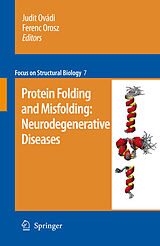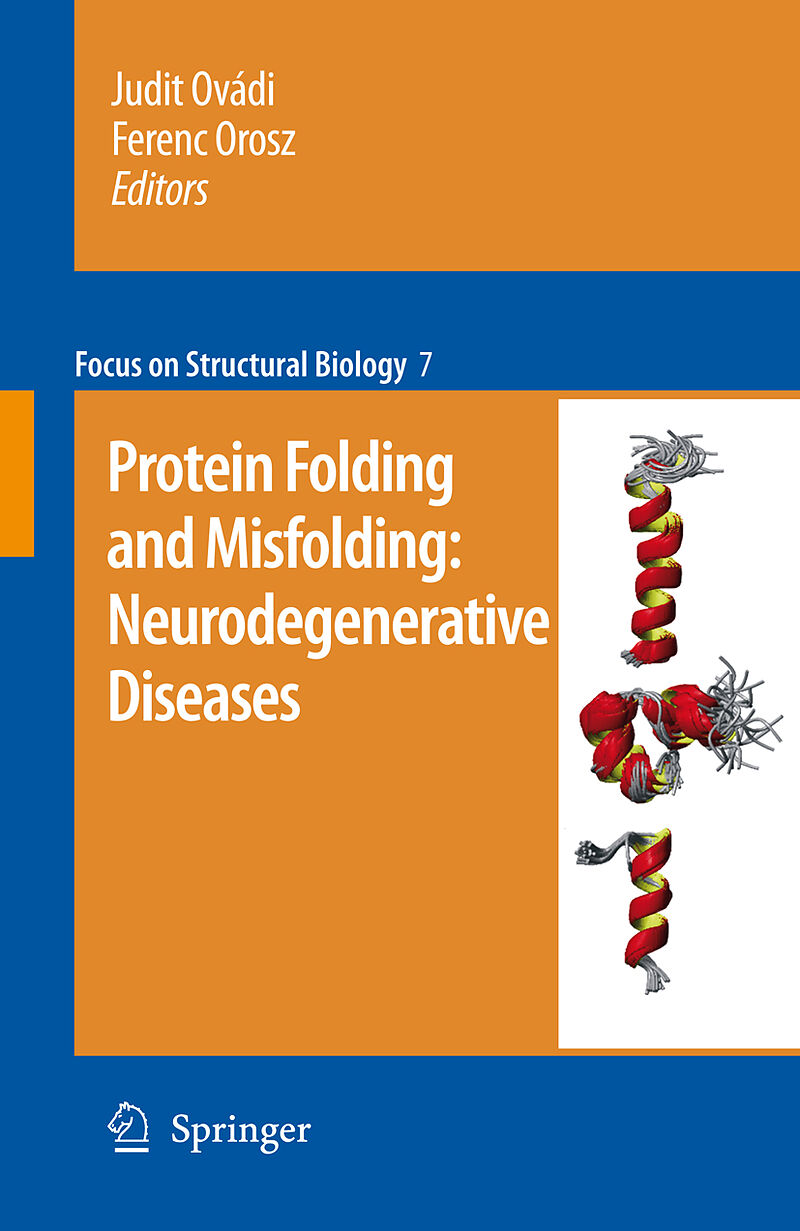Protein folding and misfolding: neurodegenerative diseases
Einband:
Fester Einband
EAN:
9781402094330
Untertitel:
Focus on Structural Biology 7
Genre:
Medizin
Herausgeber:
Springer Netherlands
Auflage:
2009
Anzahl Seiten:
296
Erscheinungsdatum:
15.01.2009
ISBN:
1402094337
Offering all the latest in the study of neurodegenerative diseases, this book reviews the molecular events initiated by unfolded or misfolded proteins leading to conformational human diseases, especially those found in Parkinson's and Alzheimer's diseases.
It was twenty ?ve years ago this year that for the ?rst time a protein under- ing a form of human cerebral amyloidosis, the Icelandic-type hereditary cerebral haemorrhage was identi?ed. This, together with the recognition that an amino acid substitution can transform the wild type cystatin C into a disease-associated amyloid-forming protein in this condition, was only a prelude to a series of imp- tant discoveries that followed. As a result, pathologically altered proteins have been brought into the centre stage of research into the pathomechanism of a n- ber of neurodegenerative diseases, which include epidemiologically such important conditions as Alzheimer s disease or Parkinson s disease and, among others, also the transmissible spongiform encephalopathies, Huntington s chorea, spinocereb- lar ataxias, frontotemporal lobar degenerations and amyotrophic lateral sclerosis. Despite the diversity in the amino acid sequence of the different proteins involved in these neurological diseases, one of the common themes underlying the patho- chanisms of all these conditions is protein misfolding, aggregation hence the term protein folding disorders , which can trigger cascades of events ultimately resulting in synapse loss and neuron death with devastating clinical consequences in many of the most precious spheres of human existence including personality, cognition, memory, skilled movements and affection. It is always a challenging task to unite the different topics of the individual ch- ters into a common theme in a multi-author volume, but the current book edited by Judit Ovadi and Ferenc Orosz ?ts this task admirably.
Will reflect the recent advances and exponential growth of the field of neurodegeneration Will also provoke questions related to the molecular base and diversity of initiation of conformational diseases up to their pathological classification Theoretical and experimental studies as well as clinical aspects will be considered Some prediction methods and experimental techniques applicable in these fields will be presented as well
Inhalt
1. Structural Disorder and Its Connection with Misfolding Diseases; Veronika Csizmok and Peter Tompa. 1.1 The Concept of Protein Disorder. 1.2 Biophysical and Bioinformatics Characterization of Disorder. 1.2.1 Biophysical Techniques 1.2.2 Bioinformatics Techniques. 1.3 Disorder in Vivo, the Effect of Crowding? 1.4 Disorder and Aggregation. 1.5 Disorder in Neurodegenerative Diseases. 1.6 Physiological Prions. 1.7 Structural Transition to Amyloid: Partially Folded Intermediates. 1.8 The Structure of Amyloid: Cross-Beta Models and Flexibility. 1.9 Conclusions. References. 2 Intrinsic Disorder in Proteins Associated with Neurodegenerative Diseases Vladimir N. Uversky. 2.1 Neurodegenerative Diseases as Proteinopathies. 2.2 Introducing Intrinsically Disordered Proteins. 2.2.1 Concept. 2.2.2 Experimental Techniques for IDP Detection. 2.2.3 Sequence Peculiarities of IDPs and Predictors of Intrinsic Disorder. 2.2.4 Abundance of IDPs and their Functions. 2.3Abundance of IDPs in Neurodegenerative Diseases. Evidence from the Bioinformatics Analyses. 2.4 Intrinsic Disorder in Proteins Associated with -Protein and Alzheimer's Disease. 2.4.2 Neurodegenerative Diseases. 2.4.1 Amyloid Tau Protein in Alzheimer's Disease and Other Tauopathies. 2.4.3 Prion Protein and Prion Diseases. 2.4.4 Synucleins - and Synuclein and Synucleinopathies. 2.4.5 Parkinson's Disease and Dementia with Lewy Bodies. 2.4.6 Polyglutamine Repeat Diseases and Huntingtin, Ataxin-1, Ataxin-3, androgen Receptor and Atrophin-1. 2.4.7 Abri Peptide and Familial British Dementia. 2.4.8 Adan in Familial Danish Dementia. 2.4.9 Glial Fibrillary Acidic Protein and Alexander and Alpers Disease. 2.4.11DNA Disease. 2.4.10 Mitochondrial DNA Polymerase Excision Repair Protein ERCC-6 and Cockayne Syndrome. 2.4.12 Survival of Motor Neurons Protein and Spinal Muscular Atrophy. 2.5 Concluding Remarks: Another Illustration of the D2 Concept. References. 3 Dynamic Role of Ubiquitination in the Management of MisfoldedProteins Associated with Neurodegenerative Diseases. Esther S.P. Wong, Jeanne M.M. Tan and Kah-Leong Lim. 3.1 Protein Misfolding and the Ubiquitin-Proteasome System. 3.2 Protein Misfolding, UPS Disruption and Neurodegeneration. 3.3 Diversity of Ubiquitin Modifications. 3.4 Non-Proteolytic Ubiquitination and Protein Inclusions Biogenesis. 3.5 Aggresomes Formation and Clearance. 3.6 K63-Linked Polyubiquitination A Novel Cargo Recognition Signal For Autophagic Degradation. 3.7 A Model of Inclusion Biogenesis and Clearance. 3.8 E2/E3 Pairs Triage officers?. 3.9 Conclusions. References. 4. Protein Misfolding and Axonal Protection in Neurodegenerative Diseases. Haruhisa Inoue, Takayuki Kondo and Ryosuke Takahashi. 4.1 Neuronal Dysfunction in Neurodegeneration Are Reversible Process. 4.2 Neuronal Dysfunction Is Not Treatable by Anti-Cell Death Therapy. 4.3 Morphological Aspects of Neuronal Dysfunction Caused by Protein Aggregation/Misfolding in Human Neurodegenerative Disorder. 4.4 Protein Misfolding and Axonal Degeneration in Experimental Animal Models. 4.5 Therapeutic approaches to treat neuronal dysfunction by axonal protection. 4.5.1 Axonal regeneration. 4.5.2 Anti-Wallerian Degeneration. 4.5.3 Autophagy Enhancement. 4.5.4 Stabilization of Microtubules. 4.6 Concluding remarks. References. 5. Endoplasmic Reticulum Stress in Neurodegeneration Jeroen J.M. Hoozemans and Wiep Scheper. 5.1Introduction. 5.2 Protein Quality Control in the Endoplasmic Reticulum. 5.2.2 Triage: ERAD. 5.2.3 Degradation: Ubiquitin Proteasome System and Autophagy. 5.2.4 Stress Response: The Unfolded Protein Response. 5.2.5 ER-Stress-Induced Cell Death. 5.3. ER Stress in Neurodegenerative Disorders. 5.3.1 Alzheimer's Disease. 5.3.2 Parkinson's Disease 5.3.3 Prion Disease. 5.3.4 Tauopathies. 5.3.5 Polyglutamine Diseases. 5.3.6 Amyotrophic Lateral Sclerosis. 5.3.7 White Matter Disorders. 5.4 Conclusions .References. 6. Involvement of Alpha-2 Domain in Prion Protein Conformationally-InducedDiseases Luisa Ronga, Pasquale Palladino, Ettore Benedetti, Raffaele Ragone and Filomena Rossi. 5.1. Conformational Diseases. 5.2. Prion Biology. 5.3. Approaches to TSE therapy: Anti-Prion Compounds. 5.4. Immune Intervention. 5.5. Prion Protein Structure. 5.6. Determinants of Prpc Conversion: the N-Terminal Region. 5.7. Determinants of Prpc Conversion: the C-Globular Domain. 5.8. Prion-Metal Ion Binding. 5.9. The a -2 Helix Domain: What Role?. 5.10. Solution Structure of Prp[173-195] and Its Analogues. 5.11. Metal Ion Titration. 5.12. Anion-Induced Effects. 5.13. Conclusions. References. 7 Synuclein Structure and Function in Parkinson's Disease. David Eliezer. 7.1 Background. 7.1.1 The Discovery of Synucleins. 7.1.2 Synuclein Mutations in Parkinson's Disease. 7.1.3 Synuclein in Lewy Bodies. 7.1.4 Synuclein Toxicity. 7.1.5 Synuclein Function. 7.2 Free State Structure. 7.2.1 Residual Secondary Structure. 7.2.2 Role of Residual Structure in Aggregation. 7.2.3 Transient Long-Range Interactions. 7.3 Fibril Structure. 7.4 Lipid-Bound Structure. 7.4.1 A Role for Synuclein Function in Disease?. 7.4.2 Secondary Structure. 7.4.3 Topology. 7.4.4 Effects of Parkinson's Disease-Linked Mutations. 7.5Synuclein. 7.6 New Model for Synuclein Function. References. 8 Inhibition of a-Synuclein Aggregation by Antioxidants and Chaperones in Parkinson's Disease Jean-Christophe Rochet and Fang Liu. 8.1 Introduction. 8.2 Molecular Details of a-Synuclein Aggregation. 8.2.1 a-Synuclein Is a Natively Unfolded, Presynaptic Protein. 8.2.2 a-Synuclein Forms Fibrils and Protofibrils. 8.2.3 a-Synuclein Protofibrils Permeabilize Membranes. …

Leider konnten wir für diesen Artikel keine Preise ermitteln ...
billigbuch.ch sucht jetzt für Sie die besten Angebote ...
Die aktuellen Verkaufspreise von 5 Onlineshops werden in Realtime abgefragt.
Sie können das gewünschte Produkt anschliessend direkt beim Anbieter Ihrer Wahl bestellen.
Loading...
Die aktuellen Verkaufspreise von 5 Onlineshops werden in Realtime abgefragt.
Sie können das gewünschte Produkt anschliessend direkt beim Anbieter Ihrer Wahl bestellen.
| # | Onlineshop | Preis CHF | Versand CHF | Total CHF | ||
|---|---|---|---|---|---|---|
| 1 | Seller | 0.00 | 0.00 | 0.00 |
